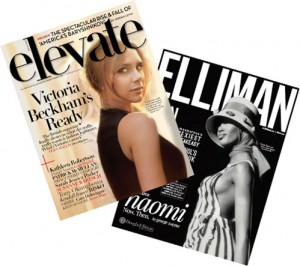Taylor Swift, Ben Stiller, supermodel Kate Upton and, of course, Spike Lee have all had courtside seats for the New York Knicks this season to bear witness to the 7-foot-tall Latvian rookie sensation Kristaps Porzingis sinking shots.
And on many game nights, Howard Lorber, the 67-year-old chairman of the mega brokerage Douglas Elliman, can be found next to that “Celebrity Row” stretch, sitting directly below the hoop.
That’s because last year, Elliman entered into a multi-year sponsorship deal with Madison Square Garden for the right to slap its grey-and-blue logo on an entire row of courtside seats at the arena. The deal also gives Elliman exclusive branding rights for the VIP lounge and a presence on the Knicks’ website, showcasing pictures of celebrities in “Elliman’s row,” where tickets typically go for upwards of $5,000 a pop.
Elliman declined to comment on the dollar value of the deal, but sources pegged it at several million dollars a year.
While the MSG deal might be considered a bold move on its own, it’s just one piece of a new marketing push by Elliman, which in the last two years has aggressively expanded into some of the wealthiest markets in the U.S., including Aspen, Los Angeles and Greenwich.
Lorber, who runs and owns Elliman with Dottie Herman, wouldn’t put an exact price tag on those efforts, but told The Real Deal the company is pouring “tens of millions” into marketing associated with its expansion. That money has gone to everything from launching glossy magazines with articles penned by Vanity Fair writers to hosting exclusive invite-only dinner parties to recruiting 2,000-plus new brokers.
The company has made clear that it’s not looking to merely take out a couple of print or web advertisements to drum up business in these new markets. Rather it’s zeroing in on the highest echelon clients by sponsoring be-and-be-seen events.
At Miami’s Art Basel, for example, it threw nightly after-parties at Casa Tua, the trendy Mediterranean-style restaurant, hosted receptions honoring artists such as Dustin Yellin and Damien Hirst and sponsored an auction for an arts foundation hosted by Russell Simmons.
At the Hamptons Classic horse show — a favorite sponsorship opportunity for the New York City brokerage world — Elliman was the only real estate company to take a private chalet for brokers and guests. It used the space to host a private fete for a diverse mix of bold-face attendees, including former New York Yankee pitcher David Cone, Representative Carolyn Maloney, former “Real Housewives of New York” star Jill Zarin and Marla Maples, Donald Trump’s former wife.
And if that weren’t enough, the company sponsored Jazz Aspen over Labor Day Weekend in Snowmass, the high-end ski resort frequented by top business execs and celebrities, and backed the 2015 Winter Equestrian Festival in Wellington, Florida.
“We want people to think of us as a high-end luxury brand,” Lorber told TRD. “That means if we’re doing something, we have to do it the biggest and the best.”
Surprisingly, in the cutthroat world of New York real estate, where firms normally try to one-up each other at every turn, rivals are not attempting to outspend Elliman.
To be sure, other top brokerages such as the Corcoran Group, Brown Harris Stevens and Sotheby’s International Realty have all done their fair share of brand marketing. For example, Corcoran’s new development arm Corcoran Sunshine recently hosted its own series of talks featuring high-profile speakers such as Larry Silverstein and architect Thomas Juul-Hansen. The firm also took out a billboard in Times Square over the holidays and launched an advertising campaign featuring photos by famed shutterbug Annie Leibovitz.
But sources say no other firm is spending anywhere near as much as Elliman.

Elliman guests in the collector’s lounge at Art Basel.
“When it comes to marketing, it’s about reach and frequency,” said Paul Purcell, managing director of William Raveis New York City and Elliman’s former president. “They’re hammering hard in every different direction. It’s not for a month or two, or a one-off campaign. It’s constant and continuous.”
Purcell said Corcoran’s marketing budget is likely curtailed because it’s part of the publicly traded real estate giant Realogy.
“You have to justify every dollar and expense when you’re part of a public company,” Purcell said. “It’s really hard to do fun and off the wall things.”
By comparison, Town Residential, which launched in 2010, recently upped its marketing budget to a massive $6 million a year, according to CEO Andrew Heiberger. That’s far less than what Elliman says it is spending. And while Elliman is a much larger company, Town is known for its aggressive and bold marketing campaigns.
“A lot of companies can’t afford to do it, and those who can, sometimes won’t,” said Lorber. “We’re still looking to grow the brand, not take every dollar of profit out of the business.”
Then again, none of Elliman’s serious New York rivals, including Town, are attempting the same high-speed national expansion that Elliman is.
In the last two years, the firm has added a massive 2,408 agents to its ranks nationwide, bringing its total agent count to more than 6,000. By comparison, Corcoran has 1,869 agents across its three regions — New York City, the Hamptons and South Florida.
“[Elliman is] becoming huge,” said one brokerage chief who asked to remain unnamed. “Many companies have tried and failed to put together a nationwide expansion, starting elsewhere and expanding into New York. They’re doing it in reverse, which should be interesting.”
Branding bona fides
Every major strategic business shift has a behind-the-scenes puppet master. At Elliman, the woman pulling the branding purse strings is Nicole Oge, a former marketing executive at Mercedes-Benz who spent three years at Town before jumping to Elliman as its global chief marketing officer in 2014.
At Town, Oge spearheaded the company’s much-acclaimed “Look up” campaign, which encouraged New Yorkers to, well, look up from their phones to snap pictures of architecture and post them to Instagram. (The firm sued her for breaking her non-compete clause when she left, but the two sides settled last year.)
Despite Elliman’s high profile in New York, the company’s brand has been somewhat in flux since 2012, when it dropped its affiliation with national home brand Prudential.
“Prudential, as a brand, never did them any favors,” said one real estate executive, who asked to remain anonymous. “As a brand, Prudential was more synonymous with Middle America and didn’t speak to the high-end market. Douglas Elliman is a much older company so that is a much stronger name in New York.”
The question now is: Can Oge change Elliman’s image and turn it into a brand that says luxury living?
By her own admission, it’s not an easy task.
“In hindsight, it was easier to build something from scratch,” Oge said, referring to Town, which launched the year before she came on. “It’s like new construction. You can do it quickly and build what you want. An older company like Douglas Elliman is more like the Plaza. It’s historic, it’s irreplaceable, but it comes with a lot of history and a certain way of doing things.”
 With an eye towards revamping Elliman’s national image, Oge has focused on investing heavily on so-called “branded content” — the trendy strategy of providing content and experiences rather than placing advertising.
With an eye towards revamping Elliman’s national image, Oge has focused on investing heavily on so-called “branded content” — the trendy strategy of providing content and experiences rather than placing advertising.
Over the past year, the company has rolled out two new quarterly luxe magazines, modeled in the vein of Vanity Fair: Elliman and Elevate. The former focuses on the New York social scene, while the latter does the same for a national audience and has a greater focus on new development. The company has long had a magazine, but until recently it was little more than a listings brochure.
The magazines, which have recruited well-known freelance writers like Vanity Fair’s George Wayne and New York Fashion Week founder Fern Mallis, have less to do with real estate and more to do with fashion, art and the lives of the rich and famous. Recent features included an interview with Victoria Beckham and a profile of Newsweek chief Tina Brown.
The strategy is not totally novel — other firms, including Compass and Town, have done the same — but no other brokerage has invested the same level of resources. Compass’ last quarterly publication, for example, was a 43-page booklet on recycled paper. And while Town’s magazine is a similar glossy tome, it weighed in at 186 pages and is only published once a year. Elliman’s clocked in at a massive 338 pages.
To some extent, the strategy mirrors what corporate giants like American Express have mastered. Back in 1984, that company launched Departures magazine, a luxe publication intended to show well-heeled cardholders how to spend their money.
Departures, and its higher-end sister publication Centurion, named for Amex’s highest-level card, have become self-sustaining businesses outside of American Express. That’s despite being launched specifically to feed the company’s brand and promote its partners — without looking like an advertisement.
“It’s not about selling something tomorrow,” said content marketing expert and author Seth Godin. “It’s about earning the trust and attention of the 10,000 or so people who are likely to impact your ability to be seen as a luxury brand. … The profit comes down the line.”
To that end, Elliman is sparing no expense on its magazines.
The issues are produced by a six-person, in-house team led by Richard Pérez-Feria — the former editor-in-chief of Time Inc.’s People en Español. They also have scores of freelance contributors on the payroll.
Elliman declined to comment on how much money the firm has thrown at the publications, but sources pegged the total cost of producing a magazine of their size and scope, including distribution, at well over $500,000 an issue.
“I’ve started to look at them almost like a fashion brand,” Purcell said. “Do Hermès and Giorgio Armani make a lot of money off of having stores on Fifth Avenue? Probably not, but it’s a large part of their brand image.”
While most agree that the magazines are visually appealing, they’ve attracted some criticism from brokers who don’t understand their purpose.
“The world doesn’t need another glossy tabloid,” said a top Elliman agent, who asked to remain anonymous for fear of retribution. “The fashion world is one thing and the real estate world is another. What do they have to do with each other?”
Lorber and Oge believe the answer is, quite a bit. “All of these art collectors are also collectors of homes for the most part,” Lorber said.
Indeed, the crossover between the high-end real estate and art worlds is well documented. Not only do top real estate players like Aby Rosen and Harry Macklowe sit atop some of the biggest art collections in the country, but so do the clients buying record-setting apartments in New York.
For example, hedge funder Ken Griffin, the rumored buyer of a $220 million penthouse at 220 Central Park South, has a vast collection, including pieces by Monet and Jasper Johns. And he is not the only one.
The Marketing Directors’ Andy Gerringer, former head of Elliman’s new development division, said the strategy makes sense.
“You’re tossing real estate, fashion, art and lifestyle into one big salad and you hope that your brand comes out shinier as a result,” he said.
Others wondered whether Elliman’s new focus on luxury might alienate some of its customers on the mid to low- ends of the residential market, who still make up the bulk of the company’s annual sales.
“That’s a question worth asking themselves,” said one industry insider.
Invite only
In addition to the magazines, the company has recently hosted dozens of invite-only events, aimed at creating associations with other high-end brands and landing the company write-ups in places like the New York Post’s Page Six. (The gossip page featured the Elliman Magazine launch party in May, noting that actress Marisa Tomei was on hand.)

From left: Dottie Herman, Howard Lorber and an event at Art Basel in Miami
Meanwhile, at Art Basel, Elliman hosted a series of panel discussions featuring speakers like W magazine editor-in-chief Stefano Tonchi, Condé Nast Traveler editor-in-chief Pilar Guzmán, developer and hotelier Alan Faena and Yellin, the contemporary artist.
While other firms hosted panels as well, Elliman was the only real estate company to purchase a booth in the exclusive “collector’s lounge,” the backstage area where bigwig art lovers congregate.
And it hosted a party celebrating the latest issue of Elevate magazine. The resident DJ for “The Ellen Degeneres Show” provided music.
Back in New York, Elliman has also rolled out a series of dinner party-style events, hosted by brokers at some of their most elaborate listings. Firms such as Town have hosted similar events but none have rolled them out with such regularity.
At a recent event hosted by top sales agent Lisa Simonsen, the listing broker for a roughly $18 million townhouse on East 64th Street, the firm partnered with Bon Appétit magazine to serve a five-course dinner to high-net worth clients, top architects such as Peter Pelsinski and real estate personalities such as Joel Seiden, founder of investment and development firm Stonehenge Partners.
These sustained efforts have not gone unnoticed in the industry.
“It’s like they dropped a bomb and everyone’s waiting to see where the dust settles,” Purcell said.
Measuring the benefits
Elliman’s marketing push and its U.S. expansion are being pursued hand in hand.
The firm opened its first L.A. office last year and recently acquired Joshua & Co., one of Aspen’s top brokerages.
A deal with international brokerage Knight Frank Residential, designed to match Elliman’s top listings with the U.K.-based firm’s global Rolodex, has also given the firm some influence across the pond. Under the terms of the deal, the two firms will join forces to market the top 10 percent of Elliman’s listings in the New York metro area, South Florida and L.A.
Measuring the benefits of all of these new efforts is not so easy, but Lorber said he’s already seeing the financial upside.
“There’s no real way to measure the benefits dollar to dollar,” he said, “but we’re attracting brokers we were never able to get before. They say Elliman looks like a completely different company than it used to.”
Among the brokers who’ve recently jumped to Elliman are Noble Black and Lauren Muss, both formerly top producers at Corcoran, and Roger Erickson, a star agent at Sotheby’s.
The company’s existing agent pool has also noticed the additional attention on marketing.
“I’ve had very generous offers from other firms but I’ve stuck with Elliman because I’m able to tell clients that we’re everywhere, from Montauk to Los Angeles,” said Marcos Cohen, Elliman’s top individual producer in 2014. “It’s a way to flex your muscles in front of the client.”
Gerringer agreed. “Realistically, they’re buying themselves market share,” he said. “I’m not sure that’s such a bad use of funds.”
